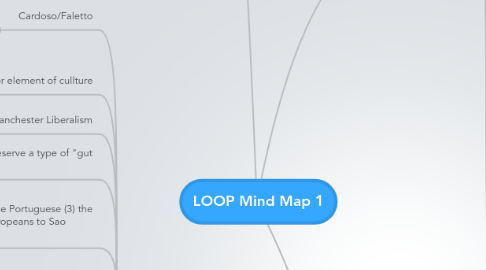
1. Introduction: Hard Laughter
1.1. "Bitter Truths and Hidden transcript"
1.1.1. Offer the avenues to understanding the culture.
1.1.2. Liberating to express burdens but doing so as conservatively as possible so as to not disrupt the order blatantly.
1.1.3. Conceal the deep injustices in a non-threatening way so that people can express themselves.
1.2. Carnavalesque
1.2.1. bad taste is embraced; people make a point to celebrate the dark humor of life.
1.2.2. pop culture is employed to hyperbolize and provide social commentary through lewdness.
1.2.3. Behavior that is "carnavalesque" as demonstrated by the popular class, is not uniquely in bad taste comparative to other countries but would be considered as such in different cultures as well as to upper and middle class Brazilians.
1.3. A lot of change with little bloodshed.
1.3.1. Class stratification seems to be continuous over time and remains through other advancements
1.3.2. History of relatively peaceful resistance
1.3.2.1. peasant rebellions are crushed, unceremoniously leaving only the disappointment of loss and inevitable defeat
1.3.2.2. GREAT SUCCESSES: (1)professionalizing their movements through creation of NGOs AND (2) significant developmental gains over time
1.3.2.3. successful uprisings have been spearheaded by those who are more privileged and have had under representation of the people they protest for.
1.4. The women in this ethnography
1.4.1. At the bottom of an intersection of hierarchies
1.4.1.1. Have little access to the women's rights movements, information and education.
1.4.1.2. so far removed that they haven't even been approached by the government attempting to exploit them for cheap labor.
1.4.2. Come from a lineage of domestic workers
1.4.2.1. employ "humor"
1.4.2.1.1. A form of resistance and a coping mechanism
1.4.2.2. assume their trajectory with disdain about life, and the way things are
1.4.2.3. abide by cultural scripts
2. Cultural Landscape of Brazil
2.1. Cardoso/Faletto
2.1.1. Removed (1) social facts were simply a matter of historical density (2) that external factors were the primary influencers/benefactors from Dependency Theory
2.2. Slavery WAS a major element of cullture
2.2.1. Died in war, "free womb" abolished in 1888 "the gloden law"; under (Rui Barbosa)
2.2.1.1. burned all records
2.3. Manchester Liberalism
2.3.1. basically Ricardo's comparative advantage
2.4. Humanitarians reserve a type of "gut Marxism"
2.5. (1) Native Americans (2) the Portuguese (3) the Italians (4) Japanese & Europeans to Sao Paulo
2.5.1. INDUSTRIALIZATION based on coffee from SP
2.5.2. Rio became the first urban professional center, forcing the poor into the outskirts
2.6. Leaders
2.6.1. Luiz Carlos Prestes: ignited the Communist party in Brazil
2.6.2. Getulio Vargas: "corporatist" big for the labor movement, ruled as a dictator; "Estado Novo" years; banned political parties, opponents nad the press until his suicide
2.6.3. Joao Goulart: mysterious election inspired political divisiveness; leftist '61-64
2.6.4. Juscelino Kubitschek: built Brasilia, attracted foreign capital and the auto industry; created foreign debt problem
2.6.5. Castello Branco: the technocrats; Costa e Silva: anti-censorship middle and upper class youth were purged for resistance 1974
2.6.5.1. exposed what lower class had been subject to
2.6.5.2. General ernesto Geisel, moderate, elected and relaxed censorship and surveillance
2.6.6. Joao Batista Figueiredo; "abertura" (political opening for return to democracy 79-85
2.6.7. Sarney: 1038% inflation
3. Chapter 1
3.1. Felicidade Eterna
3.1.1. Pseudo Shanty towns to two story houses
3.1.2. Commercial establishments were basically just bigger houses with "apartments" upstairs
3.2. Rio de Janeiro: Contrasting Inhabitants and first impressions
3.2.1. Poverty Stricken
3.2.1.1. domestic workers share intimate relations with upper class women while in their service
3.2.2. Whimsical well- to do
3.2.2.1. elements of class privilege permit more access to policy
3.2.2.2. even middle class women have maids
3.2.3. "Obscene disparities of wealth"
3.3. Discovered Brazil was referred to by other Latin Americans as a completely separate "Latin America"
3.3.1. free
3.3.2. sexy
3.3.3. enthusiasm
3.4. Carnaval:samba schools
3.4.1. Centerpieces of urban culture and afro centric
3.4.2. Carnival, the festival of Rio's poor
3.4.2.1. Da Matta, a ritual of inversion
3.4.2.2. a cathartic ritual before lent where Brazil "presents itself to the world"
3.4.2.3. assign political underpinnings at your own risk; there is high chance of overestimating Carnaval's transformative powers
3.5. Class Conflict
3.5.1. based on Bordieu's analysis; struggle leads to legitimization of social differences
3.5.1.1. habitus
3.5.1.2. "taste" as a form of class literacy
3.5.1.3. exceed the scope of economic determinism
3.5.2. Gramsci
3.5.2.1. cultural hedgemony: hides or naturalizes the dominance of one class over another
3.5.2.1.1. where hedgemony is realized domination is unnecessary; attitudes have become naturalized
3.5.2.1.2. power is independent of human agency because once someone holds a belief people can polarize over their own values; the things that persist are those elements of nature that are seamlessly a part of or reality
3.6. ethnographic refusal
3.6.1. representation is always flawed because of participation however, the goal is accuracy
3.6.2. challenges between representing things realistically and not making them appear to be persuasive and political
